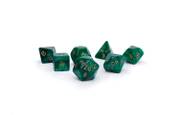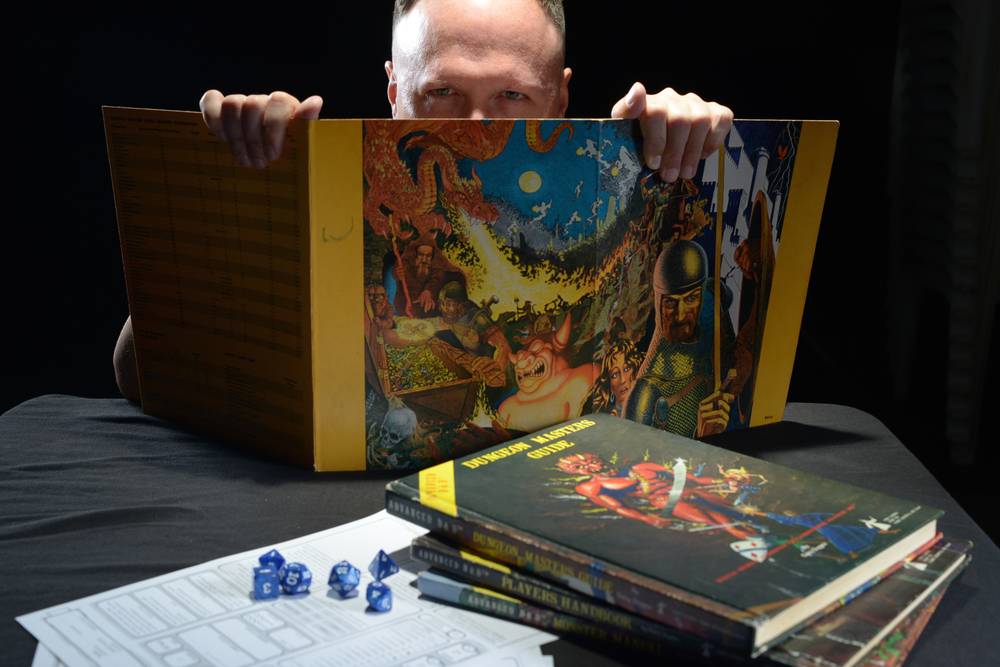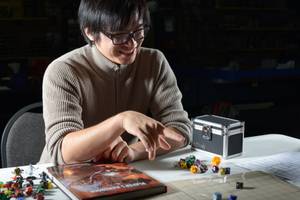This is a game that is fun. It helps you imagine. As you whirl around, your sword ready, the huge, red, fire-breathing dragon swoops toward you with a roar! See? Your imagination woke up already. Now imagine: This game may be more fun than any other game you have ever played!
That’s how a 1980s version of the Dungeons & Dragons players’ manual begins. It’s a bold statement, and it rings true today, more than 40 years after the game’s creation. Overcoming conservative criticism in its early days and giving rise to role-playing juggernauts like World of Warcraft, D&D hasn’t just survived. Its alluring world of magic and monsters has bled into novels, movies, conventions and collectors’ items, touching millions worldwide who “have stepped into the boots of mighty heroes (and sneaky antiheroes) to create their own stories.” Its website is equal parts new-player recruitment and fanbase maintenance, beckoning players to immerse themselves in the fantastical realms of fighters, rogues and wizards—human, elf, half-orc or otherwise.
Your character stands atop a grassy hill … the sun glints off your golden hair, rippling in the warm breeze … you absentmindedly rub the gem-studded hilt of your magic sword, and glance over at the dwarf and elf, bickering as usual about how to load the horses … the magic-user has memorized her spells, and says she’s ready to go … a dangerous dungeon entrance gapes at you from the mountain nearby, and inside, a fearsome dragon awaits.
Dungeons & Dragons was created in 1974 by Gary Gygax and Dave Arneson, game designers with roots in tabletop war games who set out to make one they wanted to play. What they ended up with is a cult pastime credited as the genesis of all fantasy role-playing games that followed. In D&D, a Dungeon Master leads players through meandering adventures, fighting adversaries and collecting rewards along the way. At a glance, it looks like nothing more than a primitive map, some figurines and strange dice, but the enchantment lies in the minds of players, in the never-ending, anything-can-happen voyage through Faerûn or Icewind Dale, battling owlbears for gold.

Multifaced D&D dice.
The same creativity that drives the game can be enhanced by it, if you believe star TV host Stephen Colbert and Pulitzer-winning writer Junot Diaz, who called D&D “an apprenticeship in storytelling.” Last October, comedian Patton Oswalt used D&D references to live-tweet a Republican presidential debate, showing how pervasive this once-social-leprosy-inducing pastime has become. “Ted Cruz = dwarf cleric with 3 Charisma,” Oswalt wrote. “Carly Fiorina = level 5 Drow elf with a + 1 Ring of Vampiric regeneration,” “Ben Carson = necromancer, 19 intelligence, 4 wisdom.” Even Vin Diesel plays.
As you approach the entrance, you look around. It’s a nice day, and everything seems peaceful. You know that things aren’t usually peaceful in caves where monsters live, and it’s usually dark, too. So you get out your lantern and tinderbox (matches haven’t been invented yet, so the box has flint and steel), and carefully light the wick. The flame sputters a bit, but the oil soon burns with a soft glow. With your sword ready, you step into the cave.
Las Vegas writer James Joseph Brown got into D&D as a teenager in the ’80s. “It’s a creative effort that’s part spontaneous, collaborative novel writing; part improv theater; part research project; and part anthropological study, all wrapped up into a game night with your friends,” Brown says. “It inspired me to be curious about the world. It inspired me to write. For a writer it gives you a good sense of character, setting, development. For actors, it’s a gold mine because you’re playing a character, and you can get as involved in that character as you want.”
Historically, Brown’s favorite character has been a cleric, a versatile hero who can fight and cast spells. “The different characters were a way to try on different looks, different aspects of your personality and see what fits,” he says. Though countless hours are spent honing characters, players usually reach a point when it’s time to start anew. “When it’s winding down, everyone knows it and feels it, and it’s time to move on to the next adventure.”
Suddenly, you see a goblin! He is smaller than you are, and looks like an ugly little man with gray skin. He sees, you, gives a scream, waves his sword, and attacks! You dodge his blow and raise your sword to swing.
In the beginning, D&D offered a social outlet for the awkward set, before it was cool to be a nerd, and before nerds knew of heroes like Bill Gates and Steve Jobs. It was a misfit pastime that existed outside the mainstream, a party that jocks and cheerleaders couldn’t touch. “It was fun, it was interesting, and it opened up whole new worlds,” Brown says. “It made us interested in reading and learning. I’m not gonna lie, we didn’t love it just because it was educational—the educational part was a side effect; it made us smarter and more creative—but we just liked it because it was fun and cool and awesome.”
Part of that awesomeness was the game’s artwork, featuring Herculean bikini babes and fearsome dragons planted in mysterious, pseudo-Medieval lands. This didn’t go over well with some parents, who feared the fantasy game had satanic undertones. At one point, opponents claimed D&D drove players to suicide, an accusation that was swiftly debunked. “It felt like we, the kids, were the only ones who were getting it and most of the the parents were living in a crazy world,” Brown recalls.
The stigma has obviously subsided, and Brown credits that to D&D’s early players, who grew up to be free thinkers and quirky intellectuals. (A search for D&D demographics unsurprisingly turns up character, not player, stats.) In Las Vegas, diverse gamers meet weekly at comic-book shops, welcoming noobs and veterans alike.
A hiss comes from the corner of the room to your left, and there you see a huge rattlesnake, almost 10 feet long! Near it, on the floor, are hundreds of gold and silver coins. The dead snake is not dangerous. … After resting a bit to catch your breath, you shine the lantern around, and see another corridor leading further into the darkness. Looking back the way you came, you see the light of day shining in the cave entrance in the distance. It looks tempting, but you remind yourself that you are a courageous fighter.
Jake McCarthy began playing Dungeons & Dragons when he was 15 years old and attending Narcotics Anonymous. His sponsor suggested it as a constructive social activity, and McCarthy, now 33, has played ever since. In fact, he has played all over the world and serves as Dungeon Master for three weekly online games.
“It allows people to do exactly what other avenues of tech won’t let them do,” McCarthy says of D&D’s staying power. “There’s limitations in video games, limitations in books, limitations in movies. In this iteration of the fantasy and role-playing genre, it’s limitless. … In video games, the developer has to write a static story that appeals to a wide range of personalities. This can be tailored to anyone.”
The game is the game, but the feel of its adventures is wholly dependent on the players. McCarthy’s Monday group comprises real-life friends who are more cautious, more immersed in role-playing than combat. His Canadian group on Wednesday is tactical and aggressive, strategizing online between games. And his Friday group is a bunch of buddies he used to play with 10 years ago in Portugal, who now live across the states. “We use it as a way to hang out,” McCarthy says. “I like getting people together and making sure they have a good time. It’s something that a video game could never replace.”
You carefully start down the corridor into the unknown, your lantern held high and sword ready. The corridor leads to another small cave. As you approach, you hear a voice, and see a light ...





